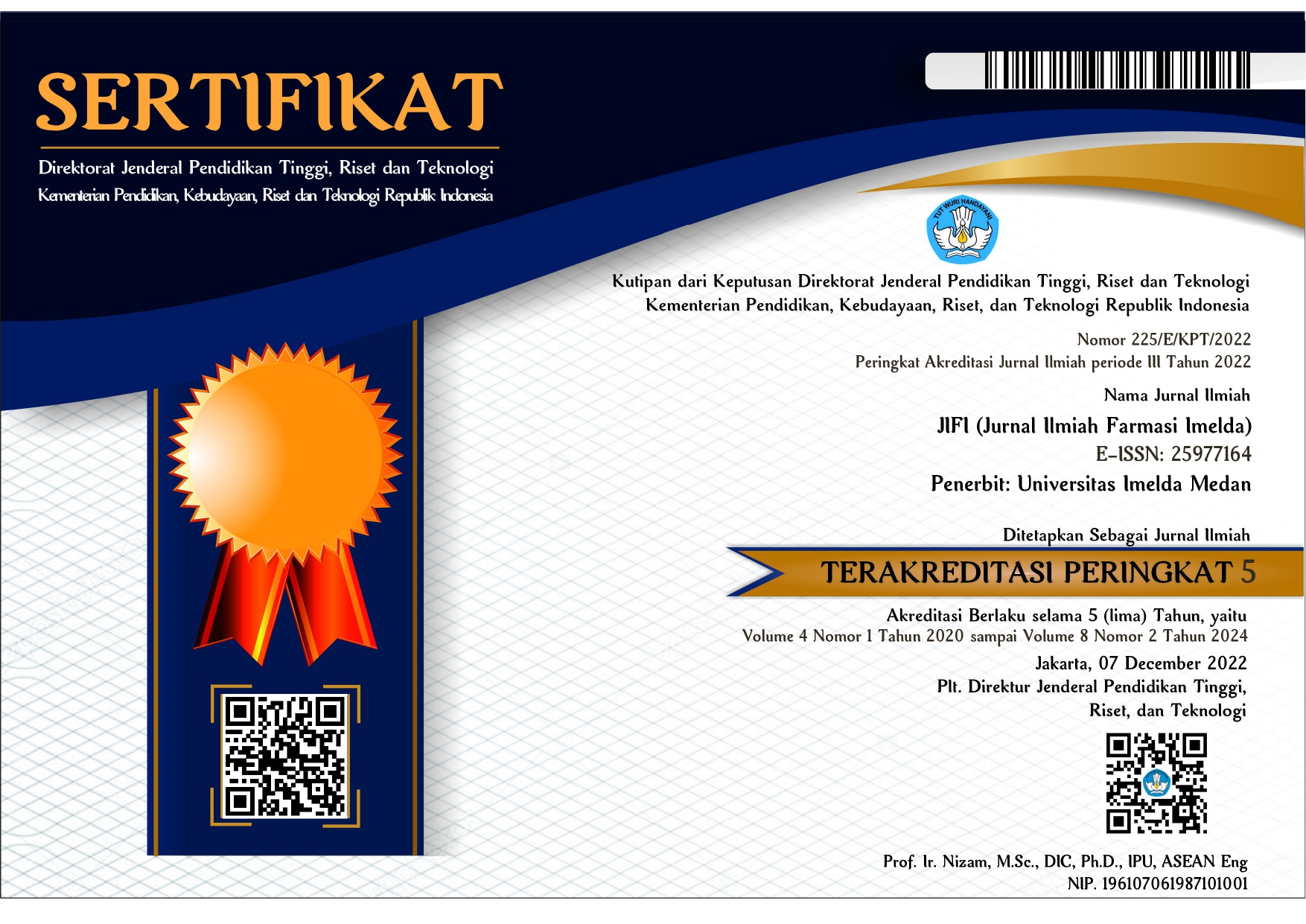POTENSI NIOSOMAL GEL SEBAGAI PENGHANTARAN OBAT ANTIINFLAMASI MELALUI SISTEM PENGHANTARAN TRANSDERMAL
DOI:
https://doi.org/10.52943/jifarmasi.v7i2.1612Keywords:
NSAIDs, Drug Delivery Systems, Nanoparticle, Niosomes, HydrogelAbstract
Nonsteroidal anti-inflammatory drugs (NSAIDs) are one of the most popular drugs used, and the WHO model lists essential medicines due to their efficacy in reducing pain and inflammation. Orally administered is prone to causing adverse reactions, while injections administered are not conducive to self-administration of the drug because the patient feels uncomfortable, thereby reducing patient compliance. Transdermal delivery is one solution because it has the potential to improve the safety profile and increase the drug's bioavailability. The use of drug delivery systems based on colloidal particulate carriers such as niosomes has advantages over conventional dosage forms because these particles can act as a reservoir containing the drug and can increase penetration. Based on the discussion presented, gel-based niosomes formulations in various research results show better drug release and permeation through the skin compared to conventional formulations. The presence of cholesterol and surfactant components plays an important role in helping drug permeation through the skin in terms of increasing the number of permeating drug molecules and the depth of permeation that occurs. Hydrogel-forming polymers are the first choice for loading niosomes because they are biocompatible and easy to obtain. Carpobol is the polymer most chosen because of its ability to spread easily, forming homogeneous and transparent preparations.
References
Akbari, J., Saeedi, M., Morteza-semnani, K., Mohammad, S., Hashemi, H., Babaei, A., Eghbali, M., Rostamkalaei, S. S., Asare-addo, K., & Nokhodchi, A. (2021). Innovative topical niosomal gel formulation containing diclofenac sodium (niofenac). Journal of Drug Targeting, 30(1), 108–117. https://doi.org/10.1080/1061186X.2021.1941060
Asthana, G. S., Asthana, A., Singh, D., & Sharma, P. K. (2016). Etodolac containing topical niosomal gel: formulation development and evaluation. Journal of Drug Delivery, 2016, 1–8. https://doi.org/10.1155/2016/9324567
Auda, S. H., Fathalla, D., Fetih, G., El-badry, M., & Shakeel, F. (2015). Niosomes as transdermal drug delivery system for celecoxib: in vitro and in vivo studies. Polymer Bulletin, 73, 1229–1245. https://doi.org/10.1007/s00289-015-1544-8
Bindu, S., Mazumder, S., & Bandyopadhyay, U. (2020). Non-steroidal anti-inflammatory drugs (NSAIDs) and organ damage: A current perspective. Biochemical Pharmacology, 180(July). https://doi.org/10.1016/j.bcp.2020.114147
Conte, R., Marturano, V., Peluso, G., Calarco, A., & Cerruti, P. (2017). Recent advances in nanoparticle-mediated delivery of anti-inflammatory phytocompounds. International Journal of Molecular Sciences, 18(709), 1–23. https://doi.org/10.3390/ijms18040709
El-badry, M., Fetih, G., Fathalla, D., & Shakeel, F. (2014). Transdermal delivery of meloxicam using niosomal hydrogels: in vitro and pharmacodynamic evaluation. Pharmaceutical Development and Technology, 20(7), 820–826. https://doi.org/10.3109/10837450.2014.926919
El-nabarawi, M. A., Bendas, E. R., El-ridy, M. S., Abdel-Jaleel, G. A., & Nasr-Alla, M. (2015). Formulation and evaluation of topical niosomal gel of baclofen. Journal of Chemical and Pharmaceutical Research, 7(1), 277–288.
El-ridy, M. S., Yehia, S. A., Mohsen, A. M., El-awdan, S. A., & Darwish, A. B. (2018). Formulation of niosomal gel for enhanced transdermal lornoxicam delivery: in-vitro and in-vivo evaluation. Current Drug Delivery, 15(1), 122–133. https://doi.org/10.2174/1567201814666170224141548
El-say, K. M., Abd-allah, F. I., Lila, A. E., Hassan, A. E. A., & Kassem, A. E. A. (2015). Diacerein niosomal gel for topical delivery: development, in vitro and in vivo assessment. Journal of Liposome Research, 26(1), 57–68. https://doi.org/10.3109/08982104.2015.1029495
G, D. B., & P, V. L. (2020). Recent advances of non-ionic surfactant-based nano-vesicles (niosomes and proniosomes): a brief review of these in enhancing transdermal delivery of drug. Future Journal of Pharmaceutical Sciences, 6(1). https://doi.org/10.1186/s43094-020-00117-y
Ghanbarzadeh, S., Khorrami, A., & Arami, S. (2015). Nonionic surfactant-based vesicular system for transdermal drug delivery drug delivery. Drug Delivery, 22(8), 1071–1077. https://doi.org/10.3109/10717544.2013.873837
Jabbar, A. S. A. (2020). In-vitro; ex-vivo assessment of anti-inflammatory Tapentadol loaded non-ionic surfactant vesicular systems for effective transdermal delivery. Systematic Review in Pharmacy, 11(12), 636–643.
Kaur, D., & Kumar, S. (2018). Niosomes: Present scenario and future aspects. Journal of Drug Delivery and Therapeutics, 8(5), 35–43. https://doi.org/10.22270/jddt.v8i5.1886
Kumar, L., Verma, S., Singh, M., Tamanna, T., & Utreja, P. (2018). Advanced drug delivery systems for transdermal delivery of non-steroidal anti-inflammatory drugs: a review. Current Drug Delivery, 15(8), 1087–1099. https://doi.org/10.2174/1567201815666180605114131
Mohamed, M. I., Kassem, M. A., Khalil, R. M., Mohamed, M., Darwish, A. B., Salama, A., & Wagdi, M. A. (2021). Enhancement of the anti-inflammatory efficacy of betamethasone valerate via niosomal encapsulation. Biointerface Research in Applied Chemistry, 11(6), 14640–14660. https://doi.org/10.33263/BRIAC116.1464014660
Mohanty, D., Rani, M. J., Haque, M. A., Jahangir, M. A., Imam, S. S., & Jamal, S. (2019). Preparation and evaluation of transdermal naproxen niosomes: formulation optimization to preclinical anti-inflammatory assessment on murine model. Journal of Liposome Research, 30(4), 377–387. https://doi.org/10.1080/08982104.2019.1652646
Muzzalupo, R., & Tavano, L. (2015). Niosomal drug delivery for transdermal targeting: recent advances. Research and Reports in Transdermal Drug Delivery, 23. https://doi.org/10.2147/rrtd.s64773
Nigro, F., Cerqueira, S., Pereira, E., Regina, C., & Mansur, E. (2020). Niosome-based hydrogel as a potential drug delivery system for topical and transdermal applications. International Journal of Polymeric Materials and Polymeric Biomaterials, 0(0), 1–18. https://doi.org/10.1080/00914037.2020.1848833
Shah, J., Nair, A. B., Shah, H., Jacob, S., Shehata, T. M., & Morsy, M. A. (2019). Enhancement in antinociceptive and anti-inflammatory effects of tramadol by transdermal proniosome gel. Asian Journal of Pharmaceutical Sciences, 15(6), 1–11. https://doi.org/10.1016/j.ajps.2019.05.001
Szura, D., Ozimek, L., Przybulo, M., Karlowicz-bodalska, K., Jazwinska-tarnawska, E., Wiela-hojenska, A., & Han, S. (2014). The impact of liposome on transdermal permeation of naproxen - in vitro studies. Polish Pharmaceutical Society, 71(1), 145–151.
Thi, Y., Tran, H., Tran, G. N., Hoang, A. L., Thi, G., & Vu, T. (2020). Niosomes loaded with diclofenac for transdermal administration: Physico-chemical characterization, ex vivo and in vivo skin permeation studies. Journal of Applied Pharmaceutical Science, 10(12), 53–61. https://doi.org/10.7324/JAPS.2020.101207
Usama, A., Fetih, G., & El-faham, T. (2016). Performance of meloxicam niosomal gel formulations for transdermal drug delivery. British Journal of Pharmaceutical Research, 12(2), 1–14. https://doi.org/10.9734/BJPR/2016/26985
Xu, Y., Zhao, M., Cao, J., Fang, T., Zhang, J., Zhen, Y., Wu, F., Yu, X., Liu, Y., Li, J., & Wang, D. (2023). Applications and recent advances in transdermal drug delivery systems for the treatment of rheumatoid arthritis. Acta Pharmaceutica Sinica B, 13(11), 4417–4441. https://doi.org/10.1016/j.apsb.2023.05.025









